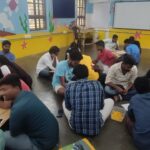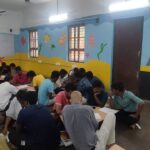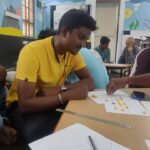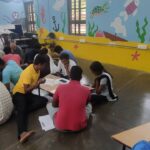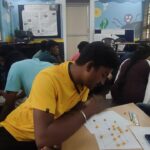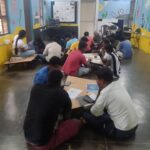The possible missing ingredients in Engineering higher education –Mastering self, agency to shift disempowering Norms and Socialization and mastering technical skills
The possible missing ingredients in Engineering higher education –Mastering self, agency to shift disempowering Norms and Socialization and mastering technical skills
Arun Arulselvam (arunarul677@gmail.com), Narmadha Anandavelu (narmadha29101997@gmail.com), Santhosh Kathiresan (sandykias@gmail.com) , Sivaraman Ramamoorthy (aurosivaraman@gmail.com) , Sri Bhavani Arul (sribhavani1998@gmail.com), Sanjeev Ranganathan (sanjeev.ranganathan@gmail.com)
C3STREAM Land Designs
Engineering higher education in India, especially rural India, does little to help youth learn about the universal values they stand for or develop their inner capacity, or develop agency to address disempowering socializations, it does not even prepare youth with practical industry ready skills. What possible missing ingredients when put in place would prepare youth for a effective and meaningful life for themselves and others? This paper is an autoethnography of five youth who are completing a one-year residential program called “Being and Becoming a Shifu (Master)”. We present how the program added these missing components in helping us connect with universal values, develop system thinking and five minds of the future, confidence in skills, being independent and interdependent and self-assessment.
RESEARCH QUESTIONS
The one year Becoming and Being a Shifu (Master) (BnBShifu) program helped us youth understand what we care about, increased self-awareness, self-regulation, responsibility, and develop confidence technical skills of VLSI (Very Large Scale Integration) layout and programming. It helped us notice our own socialization, develop system thinking. This helped develop the five minds of the future – disciplined mind, ethical mind, respectful mind, synthesizing mind and creative mind. We reflect on ‘how this happened’, or perhaps, how this could happen in Higher Education (HE) with practices at BnBShifu and its impact on us:
1) How did the program encourage youth to connect to their universal values (universal values apply for everyone, everywhere such as dignity, equity, courage)?
2) How did the program support develop system thinking, noticing patterns and five minds of the future?
3) How did the program build confidence in skills and in competence to move from being dependent to independent to interdependent?
4) How did the program provide timely feedback and build the ability of self-assessment?
We refer to universal values as those that can be embodied by everyone, everywhere irrespective of their caste, culture, gender, age, etc such as dignity, equity, courage. These form the basis of sustainable and equitable change for a thriving people and planet. When we source universal values, and express them through strategic action, multitudes of initiatives come alive, and a vast array of ideas find expression based on our aspirations, interests, and talents. Our independence is wholesome through our interdependence.
We distinguish these from the common uses of the word values in different contexts such as – something important; or a socialized culture (of a specific group, caste, or religion e.g. how women/men should dress); or in business as money added at a stage in a value chain; or as operating principles (e.g. excellence in academia, privacy in online transactions) which varies with context.
higher education in India: challengeS & opportunities
The quality of the HE institutions and colleges in India is not on par with other countries like China, Singapore (Singh, 2011). Singh states that some of the institutions are run as a profitable business where the rural and semi urban pupils are trapped. In our county 68 percent of the country’s universities and 90 percent of colleges are “Middle or poor quality”. He recommends institutional sharing between high quality institutions and these to take them to the next level. (Sheikh, 2017) suggests an alternative paradigm of new-age online learning tools to address various challenges of Indian higher education and to bring equity. Contemporary research (Manya, 2020) indicates that the Indian Education system is concentrated more on the marks rather than giving importance to the skill that has been built. Specifically, the unemployment in Engineering graduates is due to a lack of skill and competence (Tilak, 2021). Tilak shares that technology is transforming the labour market across the world 80 percent of Indian engineers are not fit for any of these jobs. India needs to interlink academia and industry.
To improve learning outcomes in HE (Harackiewicz & Priniski, 2017) suggests targeted interventions in how students value their tasks, how they engage with their academic work and their communication with their professors. Across domains students who framed their academic challenges and could self-reflect were more motivated and had better outcomes. Other solutions are linked to the need for feedback in improving the learning experience for the students in HE (Bashir, Kabir, & Rahman, 2016). That providing quality information to students about their learning and feedback to the students develops the ability of students in self-assessment.
Further there is a question of what HE should inculcate. (Ronald, 1990) argues the hidden understanding of HE beyond economics is the need to develop physiological and sociological perspective in students. Ronald highlights certain points that can be included in HE like self-reflection, open learning, group activities, interdisciplinary learning that can lead to developing these aspects.
We feel that the five minds of the future (Gardner, 2005) synthesize what is needed by youth – the disciplined mind (understanding, application and memory) for skills, the respectful mind (dignity for all), the ethical mind (human unity) caring for people and planet, the synthesizing mind (ability to notice patterns) and shift unhealthy socialization and creative mind for new solutions from care as distinguished from innovation which is only a function of the mind.
In this paper, we will look at how the BnBShifu program which offered no marks or certification developed our skill, competence and inner capacity. It started with connecting us to our potential or inner values and developing technical skills needed in the industry embracing the solutions suggested in literature including feedback from mentors, self-assessment, setting targets, peer learning, using rich online resources.
research methodology
The primary research methodology is autoethnography based on reflections of five youth (represented as ShifuX: Shifu1, Shifu2, etc respecting the blind review process) who are completing (11 months) the BnBShifu program. We feel that a methodology based on reflection is appropriate as we are addressing the lack of the reflection in youth and in our education system. We hope multiple reflections mitigate the weakness of autoethnography of not to being general enough. The gaps in HE described in literature is our lived experience as engineering graduates in rural India. We hope what was useful for us in BnBShifu will be useful for further interventions at scale.
Based on general reflections on the program we came up with questions that we felt might give a framework for us to synthesize our experience making it relevant for a broader audience. We then recorded our reflections for these questions. Given the limited length of the paper we have been selective in sharing insights and may have cut them short with ‘…’ in the hope to bring a new point. We have also dropped a question regarding how the program helped us develop healthy living which we felt was important to share with youth, but we realize many aspects were possible due to the residential nature of the course and may not be scalable. We will make all responses including those of a couple of new joiners (3 months) of the BnBShifu program available online after the review process (Arun, Narmada, et.al, 2022).
Background of participants of bnbshifu program
Sharing our background before we joined the BnBShifu program may aid understanding our reflections. We all studied engineering in colleges in villages around tier-II/III cities as shown in Table 1.
| Who | Age | Course | M/F | College Location | Work-ex |
| Shifu1 Kathiresan.S | 23 | B.Tech. EEE | M | Ariyur, Puducherry | 0 |
| Shifu2
Arul.S |
23 | B.Tech. ECE | F | Serumavilangai, Karaikal | 8 months |
| Shifu3 Anandavelu.N | 24 | B.Tech. ECE | F | Serumavilangai, Karaikal | 0 |
| Shifu4 Arulselvam.A | 24 | B.E. EEE | M | Chellankuppam, Cuddalore | 1 year |
| Shifu5
Ramamoorthy.S |
24 | B.E. ECE | M | Mailam, Villupuram | 9 months |
Table 1: Background of participants of the BnBShifu program (and authors of this paper).
Shifu1: In my college they focused only on marks and I memorized to clear all papers and not get arrears. I could tell the memorized definitions, but had no in depth to explain further. Sometimes I even forgot the definitions as I had not understood them. Even in practical exams I memorized the circuit connection by using a manual. When asked, the lab staff did not offer us an explanation of how things worked as they felt it was not needed to pass the examination.
Shifu2: …I thought scoring high marks will help me to get a job in the tech industry. After college, I got a job as a data entry operator. There was no progress in my learning except achieving targets. There I didn’t get time to take care of my health or engage in any other S
reflections to describe the BnBShifu program
Shifu4: When I first heard about the program, I thought that it will be like other usual courses of training in programming, but it was totally different from my imagination.
The application form itself was completely different from anything I had ever seen. It asked about personal information (e.g. biodata), personal knowledge (e.g. if I prefer to work early in the mornings or late at night) and personal wisdom about self-analysis, self-awareness, self-regulation, responsibility. Especially the wisdom section where they asked for universal value, cultural shift, responsibility, and healthy habits was a different experience for me and made me think.
We started the day with Surya Namaskar, running and Anna Paana meditation. We then had team meetings often with RTL (Radical transformation leadership) training sessions (Monica, 2017) and then we concentrated on learning skills and then I practiced to make myself perfect.
We interacted with each other and with our mentors to learn and also had sports or gym in the evening, at times we watched TED talk and reflected on it and the day was completed with book reading and daily reflection.
The RTL program helped me to find what I stand for and be one with my universal value; the program offers tools, templates and distinctions that connect real-life experiences and help me see problems from my universal values and come up with solutions that are in line with them and the shift I want to see in the world. It helped me address my bias and socialized fears and gave me a path to overcome them…
Shifu1: In this program I learned I stand for kindness and equity for myself and others. I committed to spending a year in the Shifu program as an input from my side. The output of the program was that I learned VLSI layout, programming in Scratch¸ Python & SKILL, Radical Transformation Leadership (RTL), Spoken English, Maths class, Book reading session, and Vipassana (VRI, 2010)… I learned to meditate and notice myself. I also changed my food pattern to a healthier diet and avoid snacking… I joined the program for technical knowledge, but here, I also learned useful life skills and RTL tools. The program also gave me time and space to think about the purpose of my life…to notice that only earning is not going to fulfill my life so I learned to serve and help others. I started teaching children (in my last semester) what I know, while teaching, I noticed that I’m also learning from them.
Shifu3: …Here the first one or two weeks it felt that we were doing so many things like learning technical skills, sport, meditation, and following ground rules…But, as I settled in, I learned time management and created time for everything to have an enriching day, each day…We also had access to STEM land a space with games and puzzles created for children where I went to learn and refresh myself. Every week we visited some places in Auroville and met new people who they shared how they are serving the community and what they care about and I was inspired to be courageous and independent like them. Once a week we also presented what we learned to others. Everyone in the program had taken up accountability like managing the kitchen, finance, maintenance, and so on this made me more responsible and accountable.
An important point that came up in all reflections was developing good habits of being disciplined about eating times, and being healthy mentally and physically.
reflections on the research questions
1) How did the program encourage youth to connect to their universal values*?
Shifu1: All of us have universal values within us, but we do not notice them or not act from them. This program had RTL which helped me think about my universal values I really care about for myself and others. Whenever I share an insight, I start by sharing my universal values. I stand for equity and kindness for myself and for others. When I keep on telling my universal values they became automatic I acted though equity and kindness. The words allow me to connect to what I deeply care about, but I’m not stuck to the words and understand their essence is to make me better. I believe RTL tools, templates and distinctions can also support youth to connect to their universal values.
Shifu2: I learned who I am being when I am at my best i.e. the universal values I hold within. I noticed that what I admire in others are qualities I want to develop within me. After discovering my universal values, I started to work from them. It made me think differently of how I can handle situations. I started to notice situations when I was not in my universal values and reflect and shift my mindset. The impact and outcome of practicing some RTL tools is it made me notice my own bias towards genderism and my own background conversations.
Shifu3: This program helps me become more self-aware and I discovered the inner values I stand for equality and happiness, through RTL. I used tools in RTL to overcome my fear and work courageously. It also made me aware of what I am doing in every situation and I learnt how to process experiences and learn from them. I started to design my projects using CFSR. I can breakdown the problem and what are the actions I can do differently to progress. I learned to be responsible.
Shifu4: …It starts with the searching what a person deeply cares about and makes him/her understand their stand… It helped me change my mentality from caring only for ‘me, myself and I’ to caring for ‘myself and others’. In addition, the Shifu program supported my problem-solving ability even technically and gave me confidence in facing the problems instead of getting into fears…We had ten days of Vipassana meditation which helped me to come out of my cravings and accept the reality to move forward. It helped to develop a concentrated mind.
Shifu5: The complete awareness of my values and for what I stand for came after attending RTL workshop…Here the values have important essence of connection for goodwill, strength and supportiveness for everyone universally.
2) How did the program support develop system thinking, noticing patterns and five minds of the future?
Shifu5: The Disciplined mind: …The program gave me the time stay with topic till I understood, applied and remembered it. I found this way of learning to be an investment for my life and it stood as a north star for my life as a programmer and being human.
The Respectful mind: Here the learning was without hierarchy. Learning from each other and supporting others to learn emphasized respect for everyone…
The Ethical mind: Vipassana meditation helped me be moral and dignified and supported put the RTL tools in practice not only being moral, ethical, but also integral (whole)…
The Synthesizing mind: …I used to memorize information, but synthesising helped me retain and look for patterns and use learning in other contexts. This included learning programming and problem solving in code-wars, reflections at the end of the day, processing a TED talk or a workshop.
The Creative mind: There are no ready-made answers to important challenges and I learned to be creative and adapt. There can be one good answer, but I learned to look for alternative possibilities that emphasis goodwill…
Shifu2: …After I learned the basics, I completed a task in that domain. After completing several tasks, I worked to synthesize the new ideas that I learned. Then I connected new learning with what I already knew. This helped me to learn new domains easily… When I heard presentations from others summarizing what they had learned and I needed to present my own learning I learned to synthesize.
Shifu3: …Initially, I wondered why with VLSI specialization I was learning programming, but as we went along I realized that I had developed my logical thinking, problem solving and automation that I applied to my specialization. I applied logical thinking in the electronics lab and the process of taking small tasks and going in depth and completing it helped me learn something new that I can use to work efficiently in the next task.
3) How did the program build confidence in skills and in competence to move from being dependent to independent to interdependent?
Shifu1: When I was new to this program, we experienced doing experiments in an electronics lab… I never had this kind of exposure in my college to do individual work…
Shifu2: Initially, I was dependent on my mentor to learn new techniques and skills in VLSI layout, then I was given tasks. As I completed tasks, I felt more confident to work independently. I noticed it took more time to complete tasks alone as compared to when I had peers who I could talk to. Sharing of new learning and discussing with peers made me feel interdependent and more efficient. This built my confidence and faith in working as a team.
Shifu5: Before joining BnBShifu I thought I’m not the type to learn programming. In the program a personal mentor guided me based on my capability. I was introduced to learning at my own pace using Coursera platform that was project based. Every time I made a project, I felt more confident. When I got stuck, I got the support of my mentor who would ask me questions rather than just give answers. After that I was introduced to code-wars a website for challenges in coding at various levels. Here, I needed to pick my challenge and I started to understand where my level was and could see how I was able to take up challenges at higher levels as I got better in programming. I became independent and could assess what I was capable of. Relating what I do with my values and in resonance with the five minds of the future gave me interdependence.
4) How did the program built the ability of self-assessment as well as provide timely feedback?
Shifu1: In this program we had an opportunity to record our insights – reflections about what I learned and about how I feel here in our daily reflections. Our mentors read and interacted with us and this helped to clear our doubts in the same day itself…
Shifu2: Getting the input and feedback from my mentors, helped me to level up my state of progress. In technical skills, mentors supported me and gave feedback that helped me notice my gaps. In time, I started noticing my own gaps and this self-assessment had a major role in my progress and learning e.g. noticing how much time I took, what ideas from a previous tasks I could have used to complete this task.
Shifu3: In college I just got marks and neither got feedback from my teachers nor did I find where I made mistakes to correct myself. But in the BnBShifu program mentors supported me by giving feedback for growth (increase, decrease, retain) to improve myself helping me identify where I was and progress swiftly.
Shifu5: I feel self-assessment of looking at patterns of how I did things and how I can make it better is the best way of assessment and helps get many creative answers. This gave me courage to neither give up if I don’t get the answer nor stop with a single answer…
Acknowledgements
To all involved in every way that made the BnBShifu program possible. We especially thank our mentors, Asha volunteers such as Anuradha, Balaji, Swati who supported and enriched the program. We thank Aura Semiconductor, Quilt.AI and Udavi school who provided the infrastructure for the program.
Conclusions
We the youth describe the missing ingredients of our education system were experienced in BnBShifu program. Here we built our leadership skills through RTL training that helped us learn what universal values we deeply cared about and want to manifest in the world building our respectful, ethical and creative mind. We developed our disciplined mind with the support of challenge-based online courses like Coursera and platforms like code-wars and practiced self-learning, peer learning, presentations, feedback and got guidance from mentors (practitioners). We developed our synthesizing mind with daily reflections, using RTL tools to process experiences and presenting what we learned technically to peers. We had access to practitioner mentors who asked us questions rather than give answers and gave feedback that helped us notice gaps and build self-assessment. As we built projects we moved from dependence, to independence to interdependence in creating a learning community with peers. There were no specific teachers, professors, no marks or certificates and yet we learned an found meaningful employment. We work in the areas of VLSI layout, software design and design automation while putting aside time to support others learn what we know as others who invested in us through the BnBShifu program. The third area design automation is a combination of the first two and was created as the program progressed.
We feel responsible to question status quo in the norms of our education system and to showcase what needs to be added to make the education system whole. We hope these ideas from this program will be scaled to benefit rural youth like us in India.
References
Bashir, M.M.A., Kabir, M.R., & Rahman, I. (2016). The Value and Effectiveness of Feedback in Improving Students’ Learning and Professionalizing Teaching in Higher Education. Journal of Education and Practice Vol.7, No.16. https://files.eric.ed.gov/Fulltext/EJ1105282
Gardner, H. (2005). Five Minds for the Future, Harvard Business School Press.
Harackiewicz, J.M., & Priniski, S., J. (2017, September). Improving Student Outcomes in Higher Education: The Science of Targeted Intervention. The Annual Review of Psychology (pp. 11.1–11.27)
Manya, J. (2020, January). A study of India’s failing education system. XXI Annual International Conference Proceedings (pp.138-149). https://tinyurl.com/bdf5bekr
Monica. S. (2017). Radical Transformational Leadership: Strategic Action for Change, North Atlantic Publishing, at Berkeley, California (pp.2-6).
Ronald, B. (1990). The Idea of Higher Education, McGraw-Hill Education (UK)
Sheikh, Y.A. (2017) Higher Education in India: Challenges and Opportunities, Journal of Education and Practice. Vol.8, No.1.
Singh, J.D. (2011, June). Higher Education in India – Issues, Challenges and Suggestions. Higher Education (pp.93-103). Lambert Academic Publishing. https://tinyurl.com/42v3ac7r
Tilak, J.B.G. (2021, March). Employment and Employability of Engineering Graduates in India. Journal of Contemporary Educational Research. https://tinyurl.com/4jaj8v6u
VRI, (2010). What is Vipassana? https://www.vridhamma.org/What-is-Vipassana
Vim Editor Session
Vim Editor Session
~SriBhavani and Bakyalakshmi
On 18th Jan 2022, we had a session on vim by HarshaVaradhan from AuraSemiconductors. In this blog, we share what we have learned about vim and how we use it.
Introduction:
Vim is a highly configurable text editor built to create and change any kind of text very efficiently. Vim Editor has its own configuration file called vimrc. This can be customizable based on how we want to see GVIM
- Vim has the Two modes of operation
- Command Mode
- Insert Mode
Command Mode:
To enter into the command mode press ESC.
There are two sub-modes in the command mode.
- Command Line Editing ? “:” followed by the command
(eg) :q- to quit the editor window
- Command-line window ? Directly enter the command It will automatically execute once it got the valid sequence
(eg) dd – delete the current line
Insert Mode:
There are two ways to enter into insert mode.
- i ? Enter into the Insert mode at the point where the cursor present
- o ? Enter into the Insert mode with the new line, next to the Cursor line
Few commands to access vim editor in the Command line window:
- dd ? Delete the cursor line.
- ndd ? Delete the n lines from the cursor position
- gg ? Go to File Starting.
- GG ? Go to End of the File.
- Ngg ? Go to nth line in the file.
- yy ? Copy the Cursor line
- Nyy ? Copy N lines from the cursor line
- u ? undo the changes
- ctrl+R ? Redo the last changes
- ggVG ? This will select all the file data
- y ? copy the selected content
- p ? paste copied content
Few commands to access vim editor in Command Line Editing
- :w ? To save the file
- :q! ? close the editor without saving the changes
- :vsp ? Split the same vim editor file in two windows vertically
- :sp ? Split the same vim editor file in two windows Horizontally
- :tabnew ? Open newtab
- :E ? To open the file tree
- :se nu ? Show line numbers in the text editor
- :se nonu ? Remove line numbers in the text editor
Search
- Type ” / “ to search a word or sentence in command mode
(e.g.) /cat – it will highlight all occurrence of word “cat” in the file
- n ? show next occurrence from current to bottom
- N ? Show search word occurrence from current to top
Search and replace:
| :%s/Old/New/gc | Search for word “Old” and replace by “New”, ask confirmation before replace |
| :%s/old/NEW/gi | Case insensitive, Search all possibilities of word “old” and replace by “NEW” |
| :%s/Old/New/gI | Case sensitive, Search “Old” replace by “New” |
| :%s/Old/New/g | Replace all occurrence of “Old” by “New”, without asking for confirmation |
MAKEY MAKEY
Makey Makey is an invention kit by the MIT media lab. With Makey Makey, everyday objects are transformed into touchpads empowering students to interact with computers as creative tools. The computer becomes an extension of their creativity, fostering imaginative play and discovery.
“Makey Makey” is a play on words – students having the ability to Make their Keyboards (“Ma-Key”). The mundane and boring keyboard is replaced by any object that conducts electricity – pie pans, Play-Doh, bananas, and even potted plants – the list goes on.
The heart of Makey Makey is its circuit board that connects to a computer via a USB cable. Building circuits that can be used like a joystick or a keyboard key allows users with no coding experience to use Makey Makey to learn, experiment, and invent.
Makey Makey paves the way for “Integrative STEM Education”. “Integrative STEM education” refers very specifically to instructional approaches that intentionally situate the teaching and learning of science, technology, engineering, and /or mathematics concepts and practices in the context of hands-on engineering, designing, and making.
The Makey Makey kit includes the Makey Makey board, a USB cable, seven alligator clips, six connector wires, and an instruction sheet.
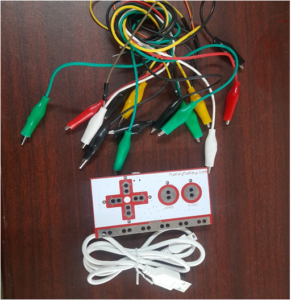
Working of Makey-Makey:
- Plug in the USB of Makey Makey to the computer.
- Connect to Earth-Connect one end of an alligator clip to “Earth” on the bottom of the front side of Makey Makey.
- Hold the metal part of the other end of the alligator clip between your fingers.
- While you are still grounded, touch the round “Space” pad on the Makey Makey. A green light should appear on the Makey Makey, and the computer will “think” the spacebar was pressed. Also, complete the circuit by connecting another alligator clip to “Space.
- Experiment by turning various items, objects, or substances into a computer key.
Using Makey Makey with scratch:
Scratch is a programming language where interactive stories, games, and animations can be created. The Chase game is an example of a program made using the Makey Makey. The game is played with the arrow keys and the notes can be remixed for an array of versions.
This chasing game was coded from scratch and used the Makey Makey kit as a joystick controller.
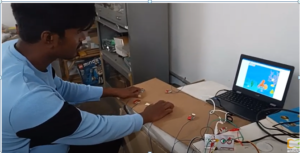
Reflection from Sri Bhavani:
From the Makey Makey hands-on projects with children, they have learned about conducting and non-conducting materials. Current doesn’t flow in an open loop. They learned the open-loop and closed-loop of a circuit. x,y coordinates while moving the sprite.
Piano using Makey Makey.
Area of the circle using the derivatives of the rectangle in GeoGebra.
Area of circle:
The area of a circle is the region covered or enclosed within its boundary. It is measured in square units. The area covered by one complete cycle of the radius of the circle on a two-dimensional plane is the area of that circle.
Area of circle formula:

Let us take a circle with a radius r from the center ‘o’ to the boundary of the circle. Then the area for this circle, A, is equal to the product of pi and the square of the radius. It is given by;
Area of a Circle, A = πr2 square units
Here, the value of pi, π = 22/7 or 3.14, and r is the radius.
Deriving the area of the circle:
The area of a circle can be visualized & proved using two methods, namely
- Determining the circle’s area using rectangles.
- Determining the circle’s area using triangles.
Using the area of a rectangle:
The circle is divided into equal sectors, and the sectors are arranged as shown in fig. 3. The area of the circle will be equal to that of the parallelogram-shaped figure formed by the sectors cut out from the circle. Since the sectors have equal areas, each sector will have an equal arc length. The blue coloured sectors will contribute to half of the circumference, and the yellow-coloured sectors will contribute to the other half. If the number of sectors cut from the circle is increased, the parallelogram will eventually look like a rectangle with length equal to πr and breadth equal to r.
The area of a rectangle (A) will also be the area of a circle. So, we have
- A = π×r×r
- A = πr2
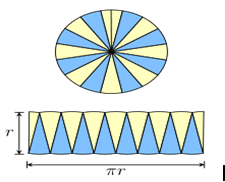
Let’s see the practical execution of the area of the circle using the derivatives of the rectangle in GeoGebra.
Step 1: By using a slider operation, create a number slider (n) with the following values.
- Set Min – 1; Max- 100 and increment as 1.
Step 2: By using a slider operation, create a radius slider (r) with the following values.
- Set Min – 4; Max- 10 and increment as 0.1.
Step 3: Plot a point A and draw a circle with radius r by keeping A as the center.
Step 4: Plot a point B anywhere on the circle.
Step 5: Give input as Rotate (B,360°/n, A).
Step 6: Now point B’ appears.
Step 7: Draw a segment between B and B’.
Step 8: Plot the midpoint C and draw a segment connecting the center and point C.
Step 9: Give the following set of inputs:
- List1=Sequence (Rotate(B,j(360°)/n,A),j,0,n).
- List2=Sequence (circularsector (A, Element (List1, j), Element (List1,j+1)),j,1,n,2).
- List3=Sequence (circularsector (A, Element (List1, j), Element (List1,j+1)),j,2,n,2).
- List4=Sequence(circularsector((jf,0), (jf+f/2,g)(jf+(-f)/2,g))),j,0,n/2-1).
- List5=Sequence (circularsector((jf+f/2,g),(jf+0,0),(jf+f,0))),j,0,n/2-1).
Step 10: Now we can observe the sectors getting formed and listed as per the input.
Step 11: Colour the sectors accordingly and insert the text for the area of the rectangle.
Step 12: By moving the number slider we observe the desired output. i.e., Area thus formed by the sectors forms a rectangle.
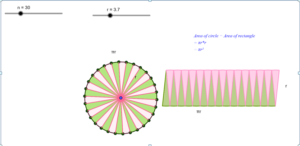
Trigonometric Functions Graph of Sin? and Cos? using GeoGebra
Trigonometry is the branch of mathematics that deals with the relationship between ratios of the sides of a right-angled triangle with its angles.
Trigonometric Functions
There are six basic trigonometric functions used in Trigonometry. These functions are trigonometric ratios. The six basic trigonometric functions are sine function, cosine function, secant function, co-secant function, tangent function, and co-tangent function. The trigonometric functions and identities are the ratio of sides of a right-angled triangle. The sides of a right triangle are the perpendicular side, hypotenuse, and base, which are used to calculate the sine, cosine, tangent, secant, cosecant, and cotangent values using trigonometric formulas.

Unit Circle and Trigonometric Values
Unit circle can be used to calculate the values of basic trigonometric functions- sine, cosine, and tangent. The following diagram shows how trigonometric ratios sine and cosine can be represented in a unit circle.
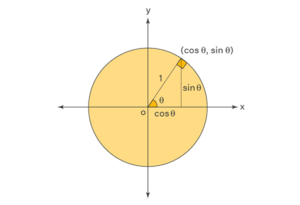
Trigonometric Functions Graph
The graphs of trigonometric functions have the domain value of θ represented on the horizontal x-axis and the range value represented along the vertical y-axis. The graph of Sinθ passes through the origin and the graph of Cosθ does not pass through the origin. The range of Sinθ and Cosθ is limited to [-1, 1].
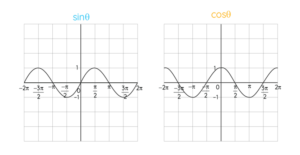
Let’s see the practical execution of the trigonometric function graphs of Sinθ and Cosθ using GeoGebra.
Steps for trigonometric function graphs of Sinθ:
- Plot two points A and B and draw a unit circle (radius=1cm).
- Mark a point C on the circle and measure angle BAC. Rename the angle as a.
- Change the settings of the x-axis by giving the distance as π/2.
- Draw a line segment between points A and C.
- Now give the input as Segment (C, (x(C),0)).
- A line drawn from C to the x-axis and point C changes with the angle change can be seen.
- Now click on settings and change the line style and colour.
- Now give input as f(x)=sin(x),0<=x<=a.
- A sine wave has drawn as per the given range can be seen.
- Now plot a point on the curve end D.
- Now, to see the change between 0 degrees to 360 degrees, give the input a Dynamic coordinate (D, a, y(C)).
- We can see the graph is drawn for every change in angle of BAC and a sine function graph simultaneously.
- Random point E appears along with the curve.
- Now give the input as Segment (E, (x(E),0)).
- Now click on settings and change the line style and colour.
- By clicking on the animation icon, the desired output can be visualized.
The figure shows the sine wave obtained using GeoGebra. It can be observed that the graph of Sinθ passes through the origin.
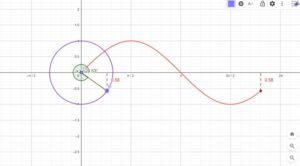
https://www.geogebra.org/classic/cdkf3rme
Steps for trigonometric function graph of Cosθ:
- Plot two points A and B and draw a unit circle (radius=1cm).
- Mark a point C on the circle and measure angle BAC. Rename the angle as a.
- Change the settings of the x-axis by giving the distance as π/2.
- Draw a line segment between points A and C.
- Now give the input as Segment (C, (x(C),0)).
- A line drawn from C to the x-axis and point C changes with the angle change can be seen.
- Now click on settings and change the line style and colour.
- Now give input as f(x)=Cos(x),0<=x<=a.
- A sine wave has drawn as per the given range can be seen.
- Now plot a point on the curve end D.
- Now, to see the change between 0 degrees to 360 degrees, give the input a Dynamic coordinate (D, a, y(C)).
- We can see the graph is drawn for every change in angle of BAC and a sine function graph simultaneously.
- Random point E appears along with the curve.
- Now give the input as Segment (E, (x(E),0)).
- Now click on settings and change the line style and colour.
- By clicking on the animation icon, the desired output can be visualized.
The figure shows the Cosine wave obtained using GeoGebra. It can be observed that the graph of Cosθ does not pass through the origin.

https://www.geogebra.org/classic/bcqtxcjr
Aadu Puli Attam
The Lambs and Tigers Game locally referred as the Game of Goats and Tigers (Tamil: Aadu puli aatam, Telugu: Meka puli aata, Kannada: Aadu Huli aata) or Pulijudam, is a strategic, two-player (or 2 teams) leopard hunt game that is played in south India. The game is asymmetric in that one player controls three tigers and the other player controls up to 15 lambs/goats. The tigers ‘hunt’ the goats while the goats attempt to block the tigers’ movements.
- This is the ancient game played in southern part of India especially in the states of Andhra Pradesh, Karnataka and Tamil Nadu.
- The board is drawn on parapet inside the mahadwara of the Chamundeshwari temple atop Chamundi Betta (hill) in Mysore, Karnataka
- This game helps people to develop strategy and concept of teamwork by teaching that even though weak, if united, one can vanquish the stronger enemy as a team.
- This game is very similar to the Korean game of Yut.
Shifu program Research paper review
———————– REVIEW 1 ———————
SUBMISSION: 8
TITLE: THE POSSIBLE MISSING INGREDIENTS IN ENGINEERING HIGHER EDUCATION –MASTERING SELF, AGENCY TO SHIFT DISEMPOWERING NORMS AND SOCIALIZATION AND MASTERING TECHNICAL SKILLS
AUTHORS: Arun Arul Selvam, Sri Bhavani Arul, Narmadha Anandavelu, Santhosh Kathiresan, Sivaraman Ramamoorthy and Sanjeev Ranganathan
———– Overall evaluation ———–
SCORE: 2 (accept)
—– TEXT:
The authors need to be appreciated for writing a reflective article on the gaps in their learning and how they overcame these gaps. Anyone who has had a moderate engagement with engineering students in India, especially those in the average technological institutions, recognizes the seriousness of the problem. The authors correctly point out that an educational system that merely focuses on making the students pass the examinations cannot provide comprehensive education.
It is often pointed out that in higher education institutions in India, including engineering colleges, students are not trained to think on their own. Relatedly, they are also generally not encouraged to build their ethical consciousness based on rationality, develop the ability to connect with others, learn something independently as well as give and take feedback in mutually helpful ways.
The authors of this article, three young men and two young women of ages 23 and 24, are engineering graduates from engineering colleges in villages around Pondicherry. They attend a program — titled BnB Shifu — which is aimed to make participants highly skilled in technical areas such as programming and VLSI Design. The stated goal of this ‘shifu’ (‘master’ in Mandarin) program is to build the skills necessary for success in the IT and electronics business by laying a strong intellectual and spiritual foundation that emphasizes “self-awareness, self-regulation, responsibility, dignity, equity and courage to create.”
The participants note that they went through several exercises as a result of which they increased their ability to focus, to learn things independently, synthesize old information and new information and get feedback from a mentor. Unlike the stressful and exam-oriented classroom practices that they had experienced in their engineering colleges, the participants were given the space to learn in a relaxed manner at their own pace. As a result of these exercises, they became more disciplined individuals and better learners; socially they became as caring about others as they were about themselves. While interacting with people in the Auroville community, they also became more courageous, which supplemented their efforts to be independent learners.
As someone teaching humanities to engineering students, this reviewer gets the sense that the “Shifu” training addresses the general gaps in technical education, especially the problems experienced by students from non-privileged and non-urban backgrounds. This paper needs our attention and the authors have an important message to convey to the planners of engineering education. This can also be seen as a plea for weaving a greater component of humanities into the engineering curriculum, which would give the students a holistic outlook and integrity in character.
However, this reviewer has some problems with the authors’ use of ‘universal values’, which purportedly are cultivated by the students through this program. In some sense, it is correct, as all students need to learn to be disciplined, focused, ethical and interactive to function optimally in academic and industry situations. However, ‘universality’ seems to erase out certain important cultural, linguistic and personal qualities, which each individual brings in as a valuable contribution to an organization.
———————– REVIEW 2 ———————
SUBMISSION: 8
TITLE: THE POSSIBLE MISSING INGREDIENTS IN ENGINEERING HIGHER EDUCATION –MASTERING SELF, AGENCY TO SHIFT DISEMPOWERING NORMS AND SOCIALIZATION AND MASTERING TECHNICAL SKILLS
AUTHORS: Arun Arul Selvam, Sri Bhavani Arul, Narmadha Anandavelu, Santhosh Kathiresan, Sivaraman Ramamoorthy and Sanjeev Ranganathan
———– Overall evaluation ———–
SCORE: 2 (accept)
—– TEXT:
Autoethnography of 5 Youth (case study-like) in 1 year residential program
– There are several long lists of what the paper is addressing (eg. self-awareness, self-regulation, responsibility, confidence, socialization, system thinking, five minds of the future etc.) It’s not clear in the beginning exactly what components of this program will be discussed and how they are all assessed. This was somewhat clarified with the research questions, but the paper could still benefit from more focus. After reading the ‘Higher Education in India: Challenges and Opportunities” section, it would be most clear if the paper were organized by the five minds of the future and to discuss all other constructs as subsets of those five main topics.
– For research methodology, the use of autoethnography is a strength and aligns with the goals of the paper since it allows for the authors to tell their own story of their own experiences. It is also a strength that both male and female students are included in the study.
– It is helpful that the authors describe the program before addressing the research questions. It is especially helpful to hear what daily life in the program is like, since it is such a holistic and immersive experience.
– It is beneficial for readers that the authors included specific details of components of the program that were helpful to them (eg. Coursera, code-wars, etc.)
– It is briefly mentioned at the end that the authors found meaningful employment. It would be helpful to learn more about the employment outcomes that have come after completion of the program.
– Overall, it is important to share this information about the authors’ experiences with this program with a wider audience. My main suggestion to the authors is to be sure the talk is organized to focus on just a few main points. When there are too many topics included, it gets confusing and difficult to follow. I wouldn’t want the important points to be lost among too much information.
Our Reflections:
Arun :
My name is Arun. I stand for happiness for myself and others. While writing the paper, it helped to recall what are all things we came through and how we worked in pears. While working with peers, I learned a lot. It helped me to break through my barriers. I’m excited to do it further because our paper got selected. I acknowledge all the people who all supported the Shifu program and gave me a valuable opportunity to write up the paper. The one that I have been through helped me to learn new things. While writing up the paper, I can easily compare my past work experience and how I’m working now.
Narmadha:
My name is Narmadha and I stand for equality and happiness for myself and others.The first time I had a chance to write a research paper and I learned how to write a research paper. While writing the research paper I have noticed how much I developed my skills and competency I learned to synthesize what I have learned and I am able to see the difference in me. We have got a positive review from researchers for our work and I felt happy and I am thankful to everyone who ever supported the Shifu program.
Santhosh:
My name is Santhosh, I stand for kindness and equity for myself and others. I had a good opportunity to share my experience in Research paper about Shifu program. When I started narrating it, I felt very happy because this will be a cultural shift and also while narrating it, I had noticed all my benefits and opportunities in learning comparing with my College learning.
Sri Bhavani :
My name is Sri Bhavani. I stand for love and equality for myself and others. It is a new and great experience for me while writing the research paper. I had a chance to reflect on my learnings
in the past year. I noticed my system shift from this course, it is shifted from marks focused to acquiring skills. We experimented with a different methodology of learning which helps us to enhance mental, physical as well as competency to work in the technical field. I am very much happy when we receive the reviews for the paper. It conveyed the essence of the paper to reviewers. I am greatly looking forward to the paper being published.
Teacher’s support website
Please find the Just in Time teachers support website link below.
Website link : https://stemlandjit.pythonanywhere.com/
Check out our old Youtube channel : https://www.youtube.com/channel/UCnaq8X41wWMlTdFw70-M8dQ
or
Our new Youtube channel: https://www.youtube.com/channel/UCE4evifjDjoOMzNfT8PQN2A
Angle sum property of a triangle using GeoGebra
A triangle has three sides and three angles, one at each vertex. The angle sum property of a triangle states that the sum of the angles of a triangle is equal to 180º. Whether a triangle is an acute, obtuse, or a right triangle, the sum of its interior angles is always 180º.
The angle sum property of a triangle is one of the most frequently used properties in geometry.
The angle sum property is used to find the measure of an unknown interior angle when the values of the other two angles are known.
Let’s see the practical execution of the angle sum property of the triangle using GeoGebra.
Step 1:
- Plot two points and draw a triangle using the polygon.
- Let’s name it ABC.
- Now find the midpoint of AC and BC by clicking on the midpoint or center icon.
- That midpoint is named point D.
- By using a slider operation, create an angle slider (r) with the following values.
- Set Min – 0 degree; Max- 180 degrees and increment as 10 degrees.
- Now by using rotate around point operation, click on point D and set the degree of rotation to slider r and set it as clockwise direction and click ok.
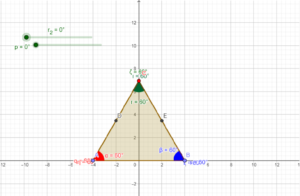
- The same way create another slider operation for p and set the corresponding angle value as p.
- By using the Angle measure operation measure the angles and label and colour them accordingly.
- Give the input as the Sum of the angles and we can see the output as 180 degrees.
- Now the slider can be moved and the angle sum property can be observed.
- Even point C can be moved to observe the angle sum property for different angle combinations.
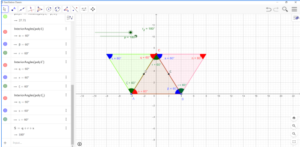
Please find the link below:
https://www.geogebra.org/classic/u6eer35p


